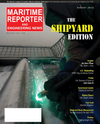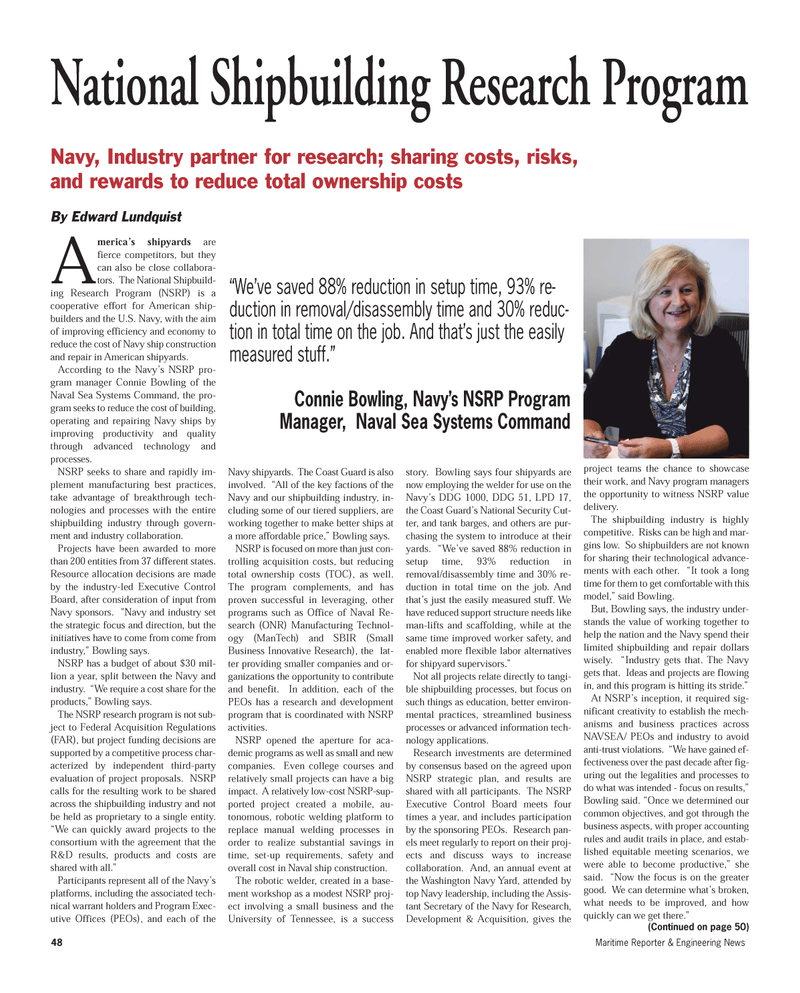
Page 48: of Maritime Reporter Magazine (August 2012)
The Shipyard Edition
Read this page in Pdf, Flash or Html5 edition of August 2012 Maritime Reporter Magazine
America?s shipyards arefierce competitors, but they can also be close collabora-tors. The National Shipbuild- ing Research Program (NSRP) is acooperative effort for American ship- builders and the U.S. Navy, with the aim of improving efficiency and economy to reduce the cost of Navy ship construction and repair in American shipyards. According to the Navy?s NSRP pro- gram manager Connie Bowling of the Naval Sea Systems Command, the pro- gram seeks to reduce the cost of building, operating and repairing Navy ships by improving productivity and quality through advanced technology and processes. NSRP seeks to share and rapidly im-plement manufacturing best practices, take advantage of breakthrough tech- nologies and processes with the entireshipbuilding industry through govern- ment and industry collaboration.Projects have been awarded to more than 200 entities from 37 different states. Resource allocation decisions are madeby the industry-led Executive Control Board, after consideration of input fromNavy sponsors. "Navy and industry set the strategic focus and direction, but the initiatives have to come from come from industry,? Bowling says. NSRP has a budget of about $30 mil- lion a year, split between the Navy and industry. ?We require a cost share for the products,? Bowling says. The NSRP research program is not sub-ject to Federal Acquisition Regulations (FAR), but project funding decisions are supported by a competitive process char- acterized by independent third-partyevaluation of project proposals. NSRP calls for the resulting work to be shared across the shipbuilding industry and not be held as proprietary to a single entity. ?We can quickly award projects to the consortium with the agreement that theR&D results, products and costs areshared with all.? Participants represent all of the Navy?s platforms, including the associated tech-nical warrant holders and Program Exec- utive Offices (PEOs), and each of the Navy shipyards. The Coast Guard is also involved. ?All of the key factions of the Navy and our shipbuilding industry, in- cluding some of our tiered suppliers, areworking together to make better ships at a more affordable price,? Bowling says. NSRP is focused on more than just con-trolling acquisition costs, but reducing total ownership costs (TOC), as well. The program complements, and hasproven successful in leveraging, other programs such as Office of Naval Re- search (ONR) Manufacturing Technol- ogy (ManTech) and SBIR (Small Business Innovative Research), the lat- ter providing smaller companies and or- ganizations the opportunity to contribute and benefit. In addition, each of the PEOs has a research and development program that is coordinated with NSRPactivities. NSRP opened the aperture for aca-demic programs as well as small and new companies. Even college courses and relatively small projects can have a big impact. A relatively low-cost NSRP-sup- ported project created a mobile, au-tonomous, robotic welding platform toreplace manual welding processes inorder to realize substantial savings in time, set-up requirements, safety andoverall cost in Naval ship construction. The robotic welder, created in a base- ment workshop as a modest NSRP proj- ect involving a small business and the University of Tennessee, is a success story. Bowling says four shipyards are now employing the welder for use on the Navy?s DDG 1000, DDG 51, LPD 17, the Coast Guard?s National Security Cut- ter, and tank barges, and others are pur- chasing the system to introduce at theiryards. ?We?ve saved 88% reduction in setup time, 93% reduction inremoval/disassembly time and 30% re- duction in total time on the job. And that?s just the easily measured stuff. We have reduced support structure needs like man-lifts and scaffolding, while at the same time improved worker safety, and enabled more flexible labor alternatives for shipyard supervisors.? Not all projects relate directly to tangi-ble shipbuilding processes, but focus on such things as education, better environ- mental practices, streamlined business processes or advanced information tech- nology applications.Research investments are determined by consensus based on the agreed uponNSRP strategic plan, and results are shared with all participants. The NSRP Executive Control Board meets four times a year, and includes participation by the sponsoring PEOs. Research pan-els meet regularly to report on their proj- ects and discuss ways to increase collaboration. And, an annual event at the Washington Navy Yard, attended by top Navy leadership, including the Assis- tant Secretary of the Navy for Research, Development & Acquisition, gives the project teams the chance to showcase their work, and Navy program managers the opportunity to witness NSRP value delivery. The shipbuilding industry is highly competitive. Risks can be high and mar- gins low. So shipbuilders are not known for sharing their technological advance- ments with each other. ?It took a long time for them to get comfortable with thismodel,? said Bowling. But, Bowling says, the industry under- stands the value of working together to help the nation and the Navy spend their limited shipbuilding and repair dollars wisely. ?Industry gets that. The Navy gets that. Ideas and projects are flowing in, and this program is hitting its stride.? At NSRP?s inception, it required sig- nificant creativity to establish the mech- anisms and business practices across NAVSEA/ PEOs and industry to avoid anti-trust violations. ?We have gained ef- fectiveness over the past decade after fig- uring out the legalities and processes to do what was intended - focus on results,? Bowling said. ?Once we determined our common objectives, and got through the business aspects, with proper accounting rules and audit trails in place, and estab-lished equitable meeting scenarios, wewere able to become productive,? she said. ?Now the focus is on the greater good. We can determine what?s broken, what needs to be improved, and how quickly can we get there.? 48Maritime Reporter & Engineering News National Shipbuilding Research Program Navy, Industry partner for research; sharing costs, risks, and rewards to reduce total ownership costs By Edward Lundquist ?We?ve saved 88% reduction in setup time, 93% re- duction in removal/disassembly time and 30% reduc- tion in total time on the job. And that?s just the easily measured stuff.? Connie Bowling, Navy?s NSRP Program Manager, Naval Sea Systems Command (Continued on page 50)MR#8 (42-49):MR Template 8/9/2012 9:45 AM Page 48

 47
47

 49
49
